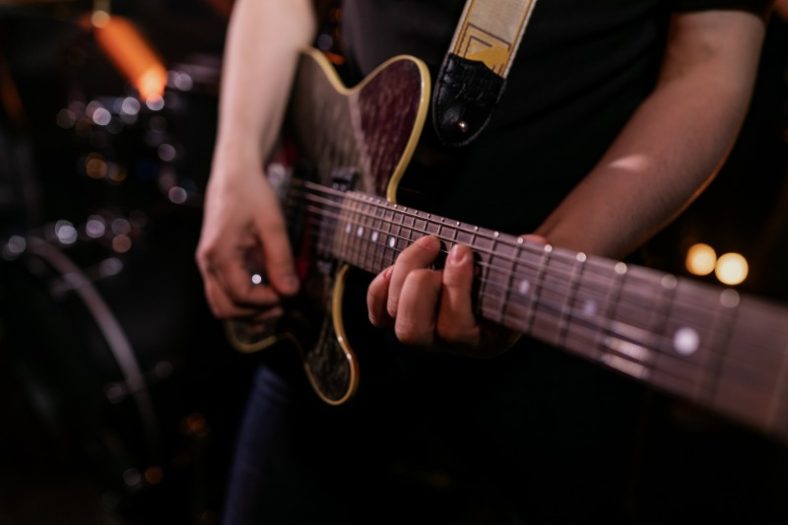10 Ways to Improve Your Sense of Rhythm on Guitar

Harmony, melody, and rhythm are the 3 fundamental building blocks of music. But rhythm is the most important factor and is the foundation of music. No matter how complex melodies you play, rhythm and timing will determine your skills. So, a proficient guitarist must master rhythm and timing.
Today, most guitar courses, books, and curriculums put most of the emphasis on harmony and melody, as chords, scales, and different techniques seem to be more important. But, playing notes at the correct time and staying in the prescribed tempo with a good sense of rhythm is a must to become a guitar master.
There are many different ways to build a good sense of rhythm on guitar, and the good thing is you do not need to study books or theory. You just have to listen to some music, play your instrument, explore different types of time signatures and rhythmic patterns, and jam as much as possible to improve your rhythmic sense.
Contents
- 1. Practice Grooving With A Metronome
- 2. Practice With A Drum Machine Or Drum Loops
- 3. Learn And Experiment With Different Strum Patterns And Rhythms
- 4. Record, Listen To, And Analyze Yourself
- 5. Try To Finger or Hand-Drum The Rhythm Of The Songs While Listening
- 6. Practice Sub-Divisions
- 7. Fix Your Picking
- 8. Tap Your Foot When You Play
- 9. Learn As Many Different Songs As You Can
- 10. Learn Some Drum Rudiments
- Conclusion
1. Practice Grooving With A Metronome
When talking about rhythm, the most important companion of a guitarist is the metronome. Playing with metronome forces you to stay in the rhythm and get the timings right while helping you notice when you are out of the rhythm.
Each note should be played at the perfect time with each click of the metronome. The process is not as simple as it sounds, as losing the beat is a very common problem. To develop a good sense of rhythm, you should play with very slow BPMs, as this will allow you to better understand the pattern. Also, your mistakes will be more noticeable, which gives you a chance to correct them.
You can start by choosing a rhythm pattern and play a single note with a metronome adjusted to a slow BPM. Try to land each note perfectly with the click. When you succeed in that, you can add different notes to the groove and make it more complex.
2. Practice With A Drum Machine Or Drum Loops
If playing with a metronome is too boring or easy for you, you can take it to the next level by playing with a drum machine or drum loops. A drum backing track can help you keep a steady beat as you practice, which can help you to improve your sense of rhythm on the guitar.
You can start by playing a chord or a single note with the groove to get the hang of it. After you feel comfortable, start adding different notes in a scale, jamming through the groove as you like. But keep your focus on the beat and try to stay perfectly loyal to the drum groove.
Playing with some backing tracks may be hard, and you may find yourself losing the beat often. In that case, try to slow down the BPM or change to a more basic groove, or limit yourself to a few notes to build your foundation. There are many great drum machines or drum loops you can use. YouTube is a great source of drum and percussion backing tracks.
3. Learn And Experiment With Different Strum Patterns And Rhythms
Enriching your strum pattern vocabulary and experimenting with different rhythmic patterns force the guitarists to get out of their comfort zones and build new skills, strengthening the sense of rhythm.
Strum patterns are great for building a better sense of rhythm as they feature many subtle nuances, such as percussive hits, accents, and embellishments. Strum patterns are rhythms applied to the guitar.
Learning different strum patterns and playing them with different rhythmic patterns will get you out of your usual playing routine and help you explore new rhythmic horizons, which can give you a better understanding of rhythm. Also, you will have a library of different strum and rhythmic patterns to deploy on different occasions without hassle.
4. Record, Listen To, And Analyze Yourself
While playing, we often don’t notice our mistakes, especially if they are recurring ones. We get used to those mistakes, not realizing we are doing something wrong. So, the best way to prevent that is to record your playing, listen to it, and analyze the strong and weak points of your playing.
This is a very efficient way to observe your skills and find the mistakes that you have to work on to correct them. Either for the sense of rhythm, new techniques, or harmony, listening to and analyzing your playing should be a routine to check your progress.
Maybe you are losing the beat or creating the same grooves, or playing too fast or slow on some occasions, or maybe you are playing perfectly. The best way to figure it out is to put the guitar aside and listen to your playing.
5. Try To Finger or Hand-Drum The Rhythm Of The Songs While Listening
Being a fake drummer is not only fun but is quite educative in many senses. Trying to tap your fingers or hands on any surface while listening to a song is a great way to improve your overall sense of rhythm.
If you struggle to do this, start by just tapping the main pulse of the song. When you get the main pulse, try to follow the drummer’s lead and add the other beats either with your fingers, hands, or feet.
Afterward, you can start mimicking the strum pattern of the guitar, the keyboard, the bass, or whatever instrument is playing the song.
6. Practice Sub-Divisions
Another great way to improve your sense of rhythm is to get better with sub-divisions. They are the foundations of every rhythm, as every groove can be divided into smaller chunks of sub-divisions. Playing 1, 2, 3, 4, 5, 6, and 7 notes per beat improves your rhythmic sense.
To develop your sense of rhythm on guitar, you have to increase the strength and fluidity of your right hand as it is the one mainly responsible for the rhythm. For this, adding a subdivision exercise to your daily guitar routine is a great idea.
You can turn on the metronome, adjust the BPM to a slow level of around 40, and start playing a single open-string note for each beat. Then go for two evenly distributed notes each beat before moving to triplets. Then you can go with 4, 5, 6, and even 7 notes evenly spaced in each beat to train your hand to be rhythmically correct. Creating muscle memory and internalizing the subdivisions will significantly improve your rhythm sense on the guitar.
7. Fix Your Picking
As mentioned before, the picking hand is mainly responsible for the rhythm when playing guitar. So, you should have a good picking technique to stay comfortably in the rhythm. Otherwise, you will get confused, losing the beat.
If you are playing with a pick, make sure your alternate picking with downstrokes and upstrokes is always on the beat with a good movement technique. If you are fingerpicking, try to be precise with the fingers you are using and do exercises to have strength in each finger.
Another way to practice is to be aware that each quarter note will be a downstroke, and each eighth note will be an upstroke. This is only applicable to alternate picking techniques with a pick, but it is a good place to start. When this feels natural, playing different rhythmic grooves will feel easier.
8. Tap Your Foot When You Play
It is scientifically proven that movement helps people to create and learn musical skills. So, letting yourself move while playing music helps you internalize the skills and solidify them in your head. Tapping your foot to the rhythmic groove you are playing can help you improve your sense of rhythm.
Many guitarists subconsciously move their heads or tap their feet to the song’s rhythm. And you should also start doing that. You can tap quarter notes or eighth notes, depending on the song, or you can tap one with the right and the other with the left foot.
9. Learn As Many Different Songs As You Can
Improving your sense of rhythm on guitar while having fun and playing some of your favorite songs is a fun as well as a great idea. As you will be familiar with these songs and how their rhythmic groove goes, you will be more comfortable replicating them with your instrument.
Playing as many songs as you can in the correct way can develop your sense of rhythm on your instrument significantly. The trick is to experiment with different songs, especially in different time signatures.
You can start with your favorite songs with more simple rhythmic patterns before moving to familiar songs with more complex patterns. You should also look for different songs in different time signatures, such as 5/4, 5/8, 7/4, 7/8, and 9/8, to learn and play. Replicating these melodies will have a great effect on your sense of rhythm on the guitar.
Another great way is to try to work some songs out by ear. Trying to play a song without looking at tabs or notes requires high concentration to pick up as much information as possible. You will not only try to figure out the chords, the harmony, or the notes but the rhythmic aspects, too, which can improve your rhythmic perception.
10. Learn Some Drum Rudiments
Finally, you can also learn and experiment with some drum rudiments and apply them to the guitar to improve your sense of rhythm. Learning drum rudiments will help you with your coordination, timing, and rhythmic accuracy, which are the basis of the sense of rhythm.
Drum rudiments like paradiddles, flams, drags and more require you to play with specific timing and accents. You can transfer this knowledge to your instrument to be more accurate and precise when you play guitar.
Start by focusing on the most fundamental rudiments like single strokes, double strokes, and paradiddles to get a better understanding of rhythm and timing. Then you can try to play them with a metronome, starting slowly and building up the speed as you get more comfortable.
When you are comfortable playing the rudiment by tapping on a surface with your hands or fingers, it is time to apply the rhythmic groove to the guitar. Try to play a single note or a simple riff and use the rudiments to create different rhythmic grooves.
Conclusion
By following these steps, you can improve your sense of rhythm in general and on guitar pretty quickly. Remember, consistency is the most important virtue when building or improving skills. If you spare half an hour daily to improve your rhythm sense, you can start to feel the difference just in a few weeks.





